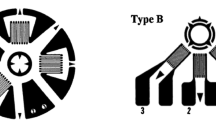Abstract
Hole-drilling measurements of residual stresses are traditionally made on materials that are either very thick or very thin compared with the hole diameter. The calibration constants needed to evaluate the local residual stresses from the measured strain data are well established for these two extreme cases. However, the calibration constants for a material with finite thickness between the extremes cannot be determined by simple interpolations because of the occurrence of local bending effects not present at either extreme. An analytical model is presented of the bending around a drilled hole in a finite thickness material and a practical procedure is proposed to evaluate the corresponding hole-drilling calibration constants.








Similar content being viewed by others
References
Schajer, G.S. and Whitehead, P.S (2013) “Hole drilling and ring coring.” Chapter 2 in “Practical residual stress measurement methods”, Schajer, G.S. (ed), Wiley, Chichester, UK
Vishay Measurements Group (1993) “Measurement of Residual Stresses by the hole drilling strain gage method.” Vishay measurements group, Raleigh, NC, Tech Note TN-503-6
American Society for Testing and Materials (2013) “Standard test method for determining residual stresses by the hole-drilling strain gage method.” American Society for Testing and Materials, West Conshohocken, PA, Standard Test Method E837-13
Steinzig M, Ponslet E (2003) Residual stress measurement using the hole drilling method and laser speckle interferometry: Part I. Exp Tech 27(3):43–46
Nelson DV, McCrickerd JT (1986) Residual-stress determination through combined use of holographic interferometry and blind-hole drilling. Exp Mech 26(4):371–378
McGinnis MJ, Pessiki S, Turker H (2005) Application of three-dimensional digital image correlation to the core-drilling method. Exp Mech 45(4):359–367
Nelson DV, Makino A, Schmidt T (2006) Residual stress determination using hole drilling and 3D image correlation. Exp Mech 46(1):31–38
Muskhelishvili NI (1953) Some basic problems in the mathematical theory of elasticity. Noordhoff, Groningen, pp 202–204
Schajer GS (1981) Application of finite element calculations to residual stress measurements. J Eng Mater Technol 103(2):157–163
Bueckner H (1958) The propagation of cracks and the energy of elastic deformation. Trans Am Soc Mech Eng 80:1225–1230
Wilson EL (1965) Structural analysis of axisymmetric solids. AIAA J 3(12):2269–2274
Zienkiewicz OC, Taylor RL (2005) The finite element method, 6th edn. Elsevier, Oxford
Schajer GS (1993) Use of displacement data to calculate strain gauge response in non-uniform strain fields. Strain 29(1):9–13
Abraham, C (2011) “Hole-drilling residual stress measurement in an intermediate thickness specimen.” MASc Thesis, Dept. Mechanical Engineering, University of British Columbia, Vancouver, Canada
Vinson JA (2005) Plate and panel structures of isotropic composites and piezoelectric materials including sandwich construction. Springer, Norwell
Young,W., Budynas, R. and Sadegh, A (2011) “Roark’s Formulas for stress and strain”, 8th ed., McGraw-Hill
Acknowledgments
The authors sincerely thank the Natural Sciences and Engineering Research Council of Canada (NSERC), American Stress Technologies, Pittsburgh, PA, and the Institute for Computing, Information and Cognitive Systems (ICICS) at UBC for financially supporting this research. They also gratefully thank Prof. R.L. Taylor for his kind support with the finite element analysis.
Author information
Authors and Affiliations
Corresponding author
Rights and permissions
About this article
Cite this article
Schajer, G.S., Abraham, C. Residual Stress Measurements in Finite-Thickness Materials by Hole-Drilling. Exp Mech 54, 1515–1522 (2014). https://doi.org/10.1007/s11340-014-9935-6
Received:
Accepted:
Published:
Issue Date:
DOI: https://doi.org/10.1007/s11340-014-9935-6




